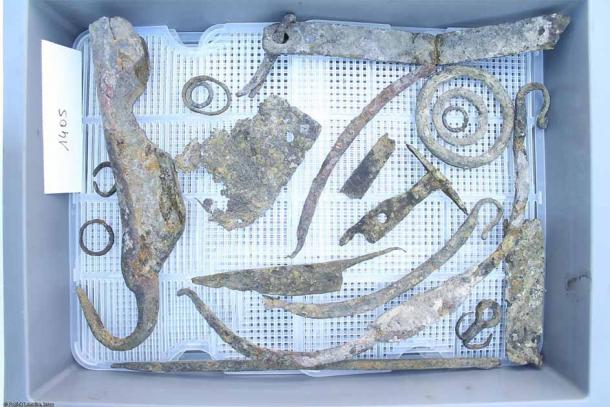
Roman Craft Center, And Shoes, Unearthed Next to French Canal
Buried in a cocoon of silt for 1,700 years, archaeologists in France have excavated a well-preserved Roman craft center. Not only did they discover evidence of butchers, tanners, shoemakers, and glassmakers, but also of the fishermen who sustained the Romans and their economy.
Thérouanne is an idyllic commune on the river Lys in the Pas-de-Calais department of the Hauts-de-France region of France. The Gallic name for Thérouanne was "Tarwanna" or "Tarodunum," and after the Roman invasion of 53 BC it became “Tarvenna” or “Teruanne.”
By 300 BC Thérouanne had become a prominent Roman city, and a team of archaeologists have just discovered a slate of evidence of Roman craftwork, including “an excellently preserved pair of Roman shoes”.
Digging Into Ancient Waterways
A team of scientists from INRAP recently excavated a canal or channel on the River Lys, in the south-east quadrant of Thérouanne. They were investigating the site ahead of the planned construction of a wastewater treatment plant. After carefully digging through around 3 meters (10 feet) of compacted river silt, which served to preserve the site, the excavators discovered the 1,700-year-old Roman “craft district”.
- Coins Dug Up in Georgia Expose Dirty Work of Legendary Legio X Fretensi
- Divers Find Huge 1,500-Year-Old Roman Coin Hoard off The Spanish Coast

View to the northwest of the excavation site, with the canal in the foreground and the glass workshop in the background. (© Frédéric Audouit, Inrap)
The INRAP press release says the craft district is represented by two buildings situated on a Roman road that runs perpendicular to the water canal. The researchers said one of the structures had particularly high walls, and floors. Furthermore, the silt casing has assured the findings are in “an exceptionally well-preserved condition.”
When Nature Works ‘For’ Archaeology
The scientists said the state of preservation at this site, “is rarely observed in peri-urban areas where the remains of buildings are usually kept below the circulation levels, at the level of the foundations.”
The science behind this is simple. Silt deposits are anaerobic (low-oxygen) environments, which slows down the decomposition rate of organic materials. Silt also protects archaeology from damaging elements like air, sunlight, and erosion, and silt also has excellent water retention properties, allowing organic materials to hold moisture for extended periods, extending their life spans.
Rediscovering Bone, Leather and Glass Craftspeople
The canal side excavation site held “butchery rejects of cattle bones.” The archaeologists said this indicates the presence of “tanning, tablet making and the manufacture of glue.” Several leather shoes were discovered that had been reinforced with studded soles and triangular leather fascinating straps.
Making leather shoes is not easy, and the discovery of a pair at the craft center suggests an experienced shoemaker was operating at the site. Furthermore, fragments of blue glass, with one coming from the filling of a furnace, leads to speculations that a glassmaker was also working at the ancient Roman craft site.
- Hundreds of Ancient Children’s Shoes found in Utah Cave
- Dated Fashion: The Tarkhan Dress, the Oldest Woven Garment in the World
Finding Out What Lies Beneath
At the silt protected craft site, the archaeologists found fragments of oversized millstones, which they say points towards the presence of a mill somewhere near the canal excavation site. Moreover, signs of the site having been rebuilt after a fire means it was inhabited for an extended period of time.
The scientists said sediment core samples from the bottom of the canal have produced “many coins, small bronze objects with gilding, stilettos, brooches, and fine golden brooches.” Furthermore, the archaeologists found “fish-gaffs (large hooks), keys, plates, and metal rods, a large exogenous pebble and grooved in length, which undoubtedly served as an anchor or ballast for a net.”

Ferrous objects discovered at the bottom of the canal (gaff, bucket handles, knife, etc.) unearthed in Thérouanne (Pas-de-Calais) in 2023. (INRAP)
Unearthing The Tools of Ancient Fishing Folk
The last list of artifacts illustrates Thérouanne’s rich fishing heritage. This important Gallo-Roman settlement had access to nearby rivers, lakes, and coastal areas for fishing. The crafts associated with fishing were essential, not only for sustenance, but in ancient Roman trade.
Thérouanne, like many Roman settlements, engaged in fishing as part of its economic and food production activities. However, this new canalside craft site functioned at the pulsing heart of the greater community, crafting and manufacturing essential items for city dwellers.
Top image: Roman shoes discovered in the canal of the River Lys during the excavation of Thérouanne (Pas-de-Calais) in 2023. Source: © Dominique Bossut, Inrap
By Ashley Cowie















